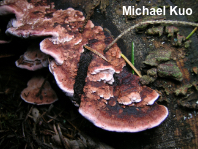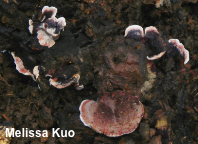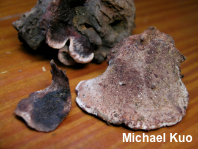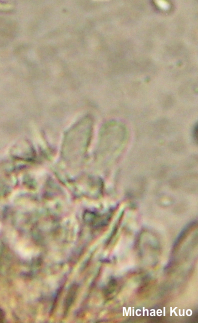| Major Groups > Polypores > Rhodofomes cajanderi |

|
Rhodofomes cajanderi [ Basidiomycota > Polyporales > Fomitopsidaceae > Rhodofomes . . . ] by Michael Kuo Widely distributed in North America's conifer forests, Rhodofomes cajanderi is a tough polypore with a gorgeous pink pore surface and, when fresh and young, pink shades on its cap surface. The caps are generally fairly thin, and often fused together, forming a structure in which individual caps are hard to define. Rhodofomes roseus is very similar, and also prefers the wood of conifers, but tends to develop more clearly separated, hoof-shaped caps; it also differs microscopically: its spores are straighter, and it lacks cystidioles. Fomitopsis cajanderi and Fomitopsis subrosea are synonyms. Description: Ecology: Saprobic on the deadwood of conifers (and, rarely, hardwoods); also sometimes parasitic on living trees; causing a brown cubical rot; growing alone or gregariously; perennial; originally described from Finland; distributed in northern Europe, Russia, China, and Japan; widespread in North America and the Caribbean. The illustrated and described collections are from California and Georgia. Cap: Individual at times, but more often fused laterally with other caps, or arranged in shelves; up to about 20 cm across and 10 cm deep; flat or broadly convex; finely velvety or hairy, or bald when older; often wrinkled; fairly soft at first, but tougher with age; pinkish brown to pinkish purple when fresh and young, darkening and developing vague zones of pinkish gray, pinkish brown, dark brown, or nearly black; usually paler on the margin. Pore Surface: Pink; bruising darker pink, then slowly brownish; with 3–5 round pores per mm; annual tube layers usually fairly distinct, up to 1 cm deep. Stem: Absent. Flesh: Pinkish; unchanging when sliced; faintly zoned; leathery to woody. Odor: Strong and fragrant when fresh. Chemical Reactions: KOH instantly black on flesh. Microscopic Features: Spores 4–8 x 2–3 µm; allantoid; smooth; hyaline in KOH; inamyloid. Basidia 10–12 x 3–4 µm; clavate; 4-sterigmate. Cystidioles 8–14 x 2–4 µm; subfusiform or irregular; smooth; thin-walled; hyaline in KOH. Hyphal system trimitic, with thin-walled clamped generative hyphae; thick-walled non-septate skeletal hyphae, and branching, thick-walled, non-septate binding hyphae. REFERENCES: (P. Karsten, 1904) B. K. Cui, M. L. Han & Y. C. Dai, 2016. (Overholts, 1953; Arora, 1986; Caranza-Morse & Gilbertson, 1986; Gilbertson & Ryvarden, 1986; Phillips, 1991/2005; Lincoff, 1992; Barron, 1999; McNeil, 2006; Kim et al., 2007; Ortiz-Santana et al., 2013; Desjardin, Wood & Stevens, 2015; Cripps, Evenson & Kuo, 2015; Han et al., 2016; Siegel & Schwarz, 2016; Ginns et al., 2017; Justo et al., 2017; Woehrel & Light, 2017; Baroni, 2017; Elliott & Stephenson, 2018; McKnight et al., 2021.) Herb. Kuo 01120604, 07141201. This site contains no information about the edibility or toxicity of mushrooms. |
© MushroomExpert.Com |
|
Cite this page as: Kuo, M. (2022, July). Rhodofomes cajanderi. Retrieved from the MushroomExpert.Com Web site: http://www.mushroomexpert.com/rhodofomes_cajanderi.html |



